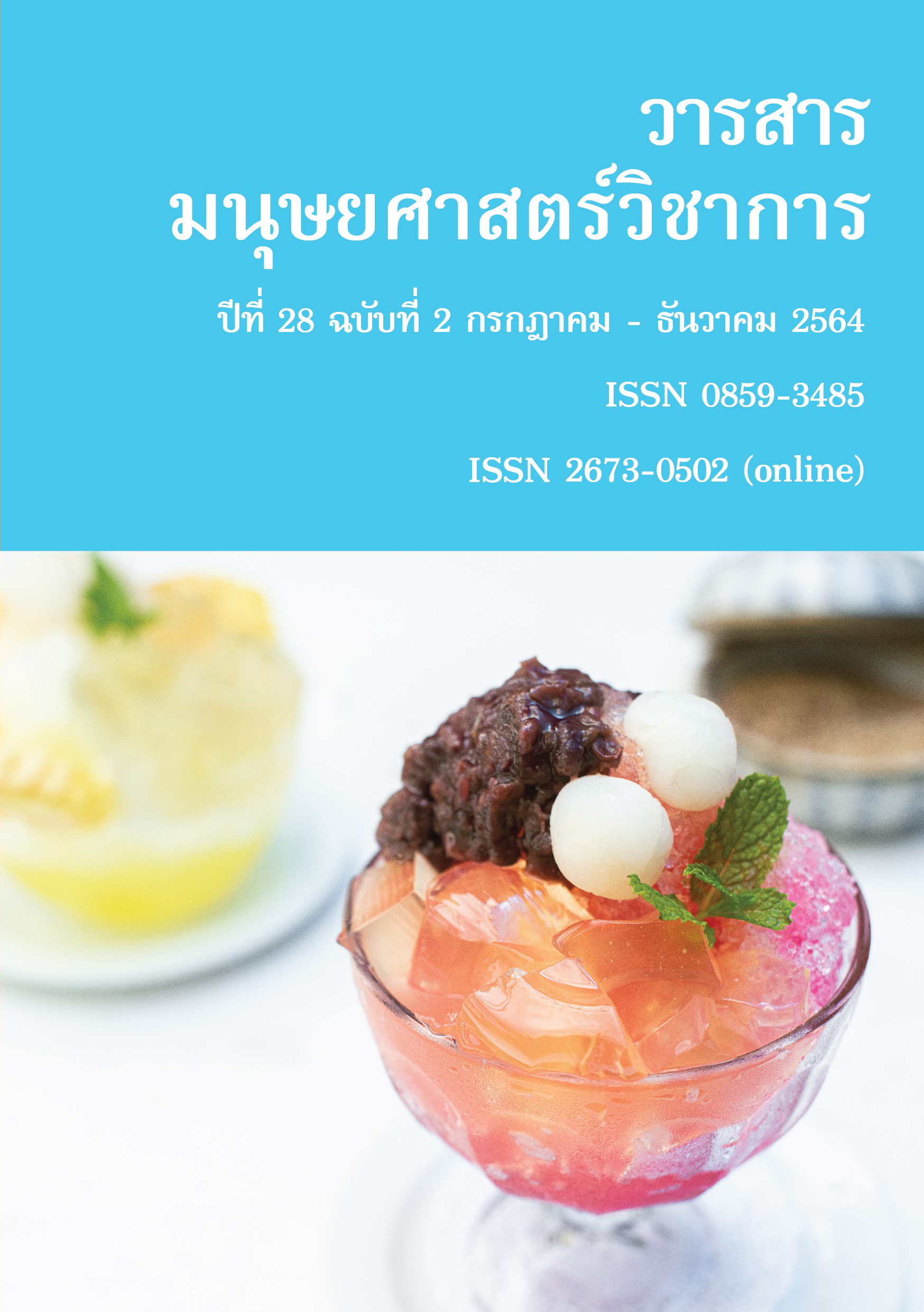An Exploratory Factor Analysis of International Food Tourist’s Motivation to Phuket, Thailand
Main Article Content
Abstract
The primary objective of this research is to examine the internal motives of international tourists for food tourism in Phuket. Prerequisite data were collected by questionnaires using convenient sampling techniques from 414 tourists. Descriptive statistics were used to summarize the demographic profile and travelling behavior. An exploratory factor analysis was employed to analyze the motivation of tourists towards food tourism in Phuket. The findings revealed that most of the tourists were the westerners, male, whose age between 21-30 years, and graduated with a bachelor's degree. The majority visited Phuket for the first time, arranged their trip by themselves, and spent their vacation in Phuket around 1-2 weeks. The results of exploratory factor analysis on motivation indicated five principal factor dimensions in the order of importance: 1) local food experience, 2) food activities and events, 3) gaining and sharing food knowledge, 4) socialization and relaxation, and 5) cultural knowledge and satisfaction. Based on the study’s findings, practical implications for food tourism market development are suggested.
Article Details
References
กัลยา วานิชย์บัญชา. (2548). สถิติสำหรับงานวิจัย. กรุงเทพฯ : ภาควิชาสถิติ คณะพาณิชยศาสตร์และการบัญชี จุฬาลงกรณ์มหาวิทยาลัย
สำนักงานเทศบาลนครภูเก็ต 2559, “นครภูเก็ตได้รับประกาศเป็นเมืองสร้างสรรค์ด้านวิทยาการอาหารของยูเนสโก” (Phuket : City of Gastronomy). สำนักงานเทศบาลนครภูเก็ต. สืบค้นเมื่อ 20 พฤศจิกายน 2563, จาก http://www.phuketcity.go.th/news/detail/1701
Chang, W., & Yuan, J. (2011). A Taste of Tourism: Visitors' Motivations to Attend a Food Festival. Event Management, 15(1), 13-23.
Department of Tourism, Ministry of Tourism and Sports. (21 September 2018). Tourist Statistics. Retrieved from https://www.mots.go.th/more_news.php?cid=504&filename=index.
Etikan, L., Musa, A. S., & Alkassim,S. R. (2016). Comparison of Convenience Sampling and Purposive Sampling. American Journal of Theoretical and Applied Statistics, 5(1), 1-4.
Fields, K. (2002). Demand for the Gastronomic Tourism Product: Motivational Factors. Tourism and Gastronomic. London and New York: Routledge.
Fodness, D. (1994). Measuring tourist motivation. Annals of Tourism Research, 21(3), 555-581.
Gee, C., Makens, J., & Choy, D. (1997). The travel industry. New York: Wiley.
Gross, M. J. & Brown, G. (2006). Tourism experiences in a lifestyle destination setting: the roles of involvement and place attachment. Journal of Business Research, 59(6), 696-700.
Guan, J., & Jones, D. (2015). The contribution of local cuisine to destination attractiveness: an analysis involving Chinese tourists' heterogeneous preferences. Asia Pacific Journal of Tourism Research, 20(4), 416-434.
Hallberg, D. (2003). Synchronous leisure, jointness and household labor supply. Labour Economics, 10(2), 185-203.
Hassan, H., Yazeed, S. & Hanim Abdullah, N. (2020). Motivation in Food Tourism in Penang. Marketing Advances and Practices. 2(1), 38-49.
Ignatov, E., & Smith, S. (2006). Segmenting Canadian Culinary Tourists. Current Issues in Tourism, 9(3), 235-255.
Iso-Ahola, E. (1982). Towards a social psychology theory of tourism motivation: A rejoinder. Annals of Tourism Research, 9(2), 256-262.
Kim, Y., & Eves, A. (2012). Construction and validation of a scale to measure tourist motivation to consume local food. Tourism Management, 33(6), 1458-1467.
Kim, Y., Eves, A., &Scarles, C. (2009). Building a model of local food consumption on trips and holidays: A grounded theory approach. International Journal of Hospitality Management, 28(3), 423-431.
Kim, Y., Goh, B. and Yuan, J. (2010). Development of a multi-dimensional scale for measuring food tourist motivations. Journal of Quality Assurance in Hospitality & Tourism, 11(1), 56-71.
Kraftchick, J., Byrd, E., Canziani, B., & Gladwell, N. (2014). Understanding beer tourist motivation. Tourism Management Perspectives, 12, 41-47.
Lin, Y. & Chen, C. (2012). Needs assessment for food and food services and behavioral intention of Chinese group tourists who visited Taiwan. Asia Pacific Journal of Tourism Research, 19(1), 1-16.
Mak, A., Lumbers, M., & Eves, A. (2012). Globalization and food consumption in tourism. Annals of Tourism Research, 39(1), 171-196.
Mak, A., Lumbers, M., Eves, A., & Chang, R. (2012). Factors influencing tourist food consumption. International Journal of Hospitality Management, 31(3), 928-936.
McIntosh, W. R., Goeldner, R. C., & Ritchie, J. R. B. (1995). Tourism: principles, practices, philosophies (7th ed.). New York: Wiley.
McKercher, B., Okumus, F. &Okumus, B. (2008). Food tourism as a viable market segment: It`sall how you cook the numbers. Journal of Travel and Tourism Marketing, 25(2), 137-148.
Meller, M. & Cerovic, C. (2003). Food marketing in the function of tourist product development. British Food Journal, 105(3), 175-192.
Mundfrom, D., Shaw, D., & Ke, T. (2005). Minimum Sample Size Recommendations for Conducting Factor Analyses. International Journal of Testing, 5(2), 159-168.
Nicholson, R., & Pearce, D. (2001). Why do people attend events: a comparative analysis of visitor motivations at four South Island events. Journal of Travel Research, 39(4), 449-460.
Nunnally, J. C., & Bernstein, I. H. (1994). Psychometric theory (3rd ed.). New York: McGraw-Hill.
Pallant, J. (2013). SPSS survival manual: A step by step guide to data analysis using IBM SPSS (4th ed.). Crows Nest, NSW: Allen & Unwin.
Park, K., Reisinger, Y., & Kang, H. (2008). Visitors' motivation for attending the south beach wine and food festival, Miami beach, Florida. Journal of Travel & Tourism Marketing, 25(2), 161-181.
Phuket Municipality. (21 October 2018). Phuket: City of Gastronomy. Retrieved from: http://www.phuketcity.go.th/news/detail/1701
Pollard, J., Kirk, S., & Cade, J. (2002). Factors affecting food choice in relation to fruit and vegetable intake: a review. Nutrition Research Reviews, 15(2), 373.
Quan, S., & Wang, N. (2004). Towards a structural model of the tourist experience: an illustration from food experiences in tourism. Tourism Management, 25(3), 297-305.
Remmington, M. &Yuksel, A. (1998). Tourist satisfaction and food service experience: results of an empirical investigation. Anatolia, 9(1), 37-57.
Sánchez-Cañizares, S.M., & López-Guzmán, T. (2012). Gastronomy as a tourism resource: profile of the culinary tourist. Current Issues in Tourism, 15(3), 229-245.
Sengel, T., Karagoz, A., Cetin, G., Dincer, F., Ertugral, S., &Balık, M. (2015). Tourists’ Approach to Local Food. Procedia - Social and Behavioral Sciences, 195, 429-437.
World Tourism Organization. (2017). Affiliate Members Report, Volume sixteen - Second Global Report on Gastronomy Tourism. Madrid: UNWTO.


